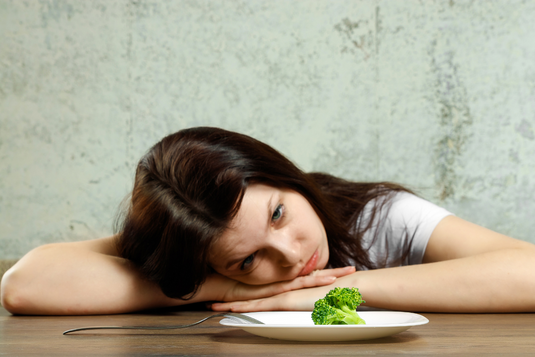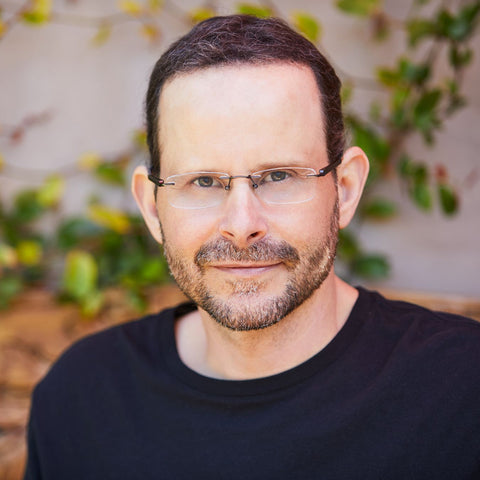We can all get caught up in the subject of what we eat. Are we eating too much? Are we eating too little? Do we eat when we are not hungry? Are we eating so much that we are getting sick? Are we controlling our portions? Do we control our daily diet? Are we deluding ourselves that we eat in moderation or balance? Do we tell ourselves that we don't need a lot of food? Are we eating the wrong things? Do we punish ourselves for eating improperly? Are we eating the wrong things to reward ourselves? What is "wrong"? Who is right and who is wrong?
Eating disorders are widespread and can happen to any of us. We are all obsessed with food. And it can't be otherwise, because we are all extremely connected to food. It's how we live, work, play, function - if food doesn't enter our bodies, we'll eventually cease to exist. It has always been part of our history as humans. What gives rise to eating disorders these days is the presence of unhealthy conditions all around us, combined with countless pollutants. What we need to do is learn to eat right to get rid of eating disorders.
Healthy diet
"Eating right" can have several meanings: to eat to heal; to eat to live, to survive; to feed to thrive; eat to function; eat to succeed.
Focusing on food is not unhealthy in itself. Often, when we try to take care of ourselves holistically and treat symptoms and conditions—buying the right foods, eating fruits and vegetables, eating less processed foods—we can feel trapped, alone, and worried about food in the bubble of our own world unless we find others like us. Even when we do it right, our lives become about what to eat, how healthy it is, where to find it. We can get lost wondering: does anyone else worry about all this?
Yes, every person on the planet should be concerned about their food. This is natural.
When trying to cure specific ailments, diseases, conditions and symptoms, this is especially natural. You have to be extra careful about what you eat. If this attentiveness to food manifests itself in the wrong way, it can contribute to an eating disorder. If done the right way, it can correct an eating disorder and teach you how to eat properly.
Eating the right foods at the right times can look like an eating disorder because of how others perceive it. When you try to eat healthy, others often see it as too strict. They may even define it as orthorexia, which you will read about in a special article that you can expect soon on our blog. They can accuse you of eating "too much fruit", "not enough protein", "too many carbohydrates". The list is endless. Bringing your own food to the holidays, refusing to eat at events where the menu isn't right for you, constantly packing snacks, orienting your life around the farmer's market or making special requests at restaurants should not be considered an eating disorder , when what you are doing is eating to truly heal yourself.
Don't we want to feel normal? Let's go out and have pizza, fried food, mac and cheese, a burger or maybe sushi. Let's go to a friend's house and eat whatever they serve us, and then eat ice cream. To eat whatever is on the family holiday table without worrying about how it will affect our bloating, stomach cramps, gastritis, diarrhea, constipation, acid reflux, indigestion and acne. We all want to feel normal. The irony is that all the people who seem normal are actually normalizing dysfunctional eating and have eating disorders themselves. They are not eating properly. No one has ever been taught what our brains and bodies need, what foods our organs need, what foods to eat for our physical, spiritual, emotional and mental health. We are left to our own destruction.
In order to heal, you need to be aware of what to eat. You have to choose your food items and arrange them. When the food items are out of order, then an eating disorder occurs. Everyone has been in this position – wondering what to eat, and everyone is guessing.
In many cases, food contributes to making you feel unwell. Eating foods that are not medically appropriate can contribute to the development of a condition, disease or illness. So what seemed normal—eating normal, behaving normally, being normal with food—wasn't good "normal." It may have seemed like good "normal" because you were with family and friends. It may have seemed normal because the food was delicious and filling. It may have looked normal because it was comfortable. It may have seemed like a good normal because it offered comforting sensations that connected you to past life memories. Yet it has not been good for other reasons.
People who try to use food to heal themselves, especially young people, are often accused of eating wrong. In older times this was even more common. Especially if it was a young person trying to heal from a chronic illness by eating fruits and vegetables, he could have been taken to a clinic and force-fed, prodded by well-meaning family members who actually were those with eating disorders or were very scared because the young person's diet was so different from what they thought was normal.
We are now in a better and more secure place in terms of food than we were two decades ago. Eating more plant-based foods is more acceptable – not completely, but becoming more acceptable. There is still a lot of confusion around eating disorders and healthy eating, and rightfully so. There are many trends in health that are not right for the body and can spoil the good gains from the right approaches in holistic health. Some health professionals get reckless and it ends up looking bad for everyone in the alternative health field. People who embark on certain cleanses, certain detox programs and certain diets already have eating disorders. And when they do these reckless diets and cleanses, it makes their eating disorders worse, creating even more confusion, fear, and frustration. This can give healthy eating a bad name and even start a new eating disorder because the creators of these diets and programs have no idea why someone is sick in the first place, so the information they give others is wrong.
Improper nutrition
There are different levels of eating disorders. Not eating all day, surviving only on coffee, and then eating mostly in the evening - these are eating disorders. Binge eating at every meal, whether you feel uncomfortable or eat while barely breathing: this is an eating disorder. Trying to control your portions at every meal without considering your hunger: this is an eating disorder. Counting every single calorie and cutting out healthy foods because of the calorie count is an eating disorder. Enrolling in trendy diet programs and following all the rules without regard to how you feel is an eating disorder. Injecting yourself with modern hormones or taking hormone pills while eating 500 calories a day is an eating disorder. A radical cleanse, where you eat and drink almost nothing for weeks or even a month, is an eating disorder.
Less obvious forms also exist. Trying to pressure others to eat less good foods because you don't want to feel bad about eating those foods is an eating disorder. Eating foods in front of your loved ones that you know will tempt them and derail their healthy eating plans: this is an eating disorder. Regular consumption of diet soda: this is an eating disorder. Constantly thinking about food is an eating disorder. Not thinking about food—pretending you don't need it, letting your blood sugar drop, not planning what you're going to eat—and that's an eating disorder. If the food is not exactly what you ordered and it leads to a meltdown - this is an eating disorder. Eating whatever someone throws in front of you is an eating disorder. Eating only while driving is an eating disorder. Always sitting at the table to eat is an eating disorder. Eating only while standing is an eating disorder. Gobbling down food and clearing the plate in record time is an eating disorder. The list is endless.
Eating habbits
What are the causes of these everyday eating disorders? Often these are the conditions. For example, when children go to camp, boarding school, or a friend's house, many rules about eating usually apply. At certain mealtimes, when only what is served is allowed to be eaten and there is no easy access to food outside of these times, it is common to get into the habit of hoarding treats and treats such as candy and chips—a habit that can to continue later in life, even when the same restrictions are no longer in place.
Another example is a person who grew up in a family where there was a limited amount of food on the table at every meal, so if you don't fight for yourself and gobble up what you can, you won't get food. The faster you eat, the more likely you are to get an extra portion.
These are just two examples. There are hundreds of ways we can describe ourselves through our eating habits. Even if circumstances change, fear and habits can remain.
Under such conditions, your brain receives messages that you will not be able to eat what you want, when you want, find the food you really want, or find food at all. And subsequently, these messages often do not change for years. After all, in adulthood, people still live with this childish feeling that they may not be able to get enough food. It's like getting burned by a hot stove. Once you learn that early lesson that you can be hurt by a hot surface, you are always cautious around one. If in your youth you often went to bed hungry, it is like burning yourself. Your brain has stored this information, so approaching the dinner table can have the same charge as approaching a stove—it can sharpen your attention and give you the same sense of caution that you will carry throughout your life.
Unless you recognize it and rewire your brain. While the memory of that injury will always be there, you can still build a new database, a new foundation around nutrition.
Altered taste
Here's another factor that contributes to everyday eating disorders: taste. When two people eat the same food, they tend to think they are experiencing the same thing. But this is not so. When you sit next to someone and eat the same macaroni and cheese, the same biscuit, or the same soup—even when you both love those dishes—what each of you perceives as a taste is completely different. Our taste buds and palate are controlled by our central nervous system. This means that our brain controls our taste sensations. Language is only a tool.
People often think that the mouth controls taste. This is not quite true. If you put a cough drop or gum in your mouth, it will change the taste of everything you eat afterwards. The taste buds can become saturated with something toxic, pungent, spicy or acidic and it can change your taste. Cigarettes, for example, can alter taste sensations, as can artificial flavors. It is a taste pollution that comes through the mouth and even through the nose.
Leaving aside this kind of taste contamination, the brain controls our sense of taste and aroma. Signals travel back and forth between the mouth and the brain via the hypoglossal and glossopharyngeal nerves, which exit the brainstem. It is these neural messages in the brain that really determine a person's perception of bitterness, for example. This is part of the reason people have certain food preferences: the brain makes people perceive the experience of eating food in a certain way. Any interference with the brain at any level – like toxins in the brain – can change the way we perceive tastes in the mouth because either the cranial nerves are affected by the toxins or the neurons that send messages to those nerves are affected. So if the brain has any solvents, monosodium glutamate, toxic heavy metals, petrochemicals, pesticides, herbicides, other toxic chemicals, or viral neurotoxins accumulated in the brain tissue, it can affect whether someone likes or dislikes certain foods and drinks. For example, when someone has elevated levels of mercury or other toxic heavy metals in the brain or brainstem, cilantro will not taste good. Instead, this person will not tolerate cilantro and will even find it repulsive. As it cleans the toxic heavy metals to a minimum, the taste of cilantro changes and becomes tolerable, even pleasant.
It's not just about taste. Whether or not people like certain food textures depends on which pests have taken up residence in the brain and where. For example, you'll hear people say, "I don't like the texture of avocado," "I don't like anything mushy," "I only like crunchy things," or "I like something I can sink my teeth into"—this is because of what's happening in the brain .
Often, toxins in the brain and early life eating habits go hand in hand to shape our perceptions of food. When you are told in childhood that you must eat something, or when you have a bad experience with a certain food at a friend's home, it can lead to a lasting aversion. For example, if you're sitting at your friend's dinner table while his parents make him clear his plate and eat all his meat before he gets dessert, this could lead to an eating disorder. Add to that any toxins in the brain that contaminate its messages to the tongue and nose, and we see how each person ends up with unique variations in taste for food.
Have you ever wondered why a family member doesn't like a food that you love? Or why a friend finds the taste of a dish so amazing that he can't get enough of it, and you try it and say, "Well, it's okay. It's not bad"? How is it possible for a person to find a food so delicious, comforting and good, while their parent, sibling, partner, boyfriend or girlfriend doesn't like it? Because they are trying two different things again. Perhaps one of the tasters had a bad experience, such as food poisoning, and will no longer go near a certain type of food. It is an emotional and physical brain wound. It's not as simple as "Oh, people have different tastes" or "We just have different tastes". It is much more than that; it's all about the brain. It's "Wow, this person could have many different levels of brain contamination," or "Wait a minute, I could have contamination." It's "This guy might have emotional scars" or "Wait, I might have scars from growing up."
Wake up calls
Sometimes an event in your life wakes you up from your daily eating disorder. For example, what happens when you go to the doctor and out of the blue he tells you, "You are a type 2 diabetic"? Often the experience will scare the person and cause them to start eating new foods, ones they may have never tried before, out of a certain comfort zone. Instead of drinking only coffee all morning, gorging on a double cheeseburger and a soft drink for lunch, and ordering greasy takeout for dinner, being shaken by the threat of this diagnosis helps you make a different choice. It's as if the shock of your doctor giving you the bad news helped you break your eating disorder.
Sometimes that won't help. Some people are told that they have type 2 diabetes or that they are pre-diabetic, but they just can't change their diet even if they have the means, and instead want whatever medication they can to compensate. Which path is chosen depends on how severe the eating disorder is, how deep it is ingrained in the central nervous system, and your lifestyle. It depends on what happened along the way - what abuses and hardships - and how saturated the brain is with toxins.
Whatever eating disorder you're dealing with on a daily basis, whether it's an aversion to foods you know would help you heal, an eating pattern that doesn't serve you, or a similar struggle, you can change it , if you detox your brain. As people begin to flush toxic heavy metals and other brain-damaging substances out of their bodies, they begin to like different foods and feel better day by day.








